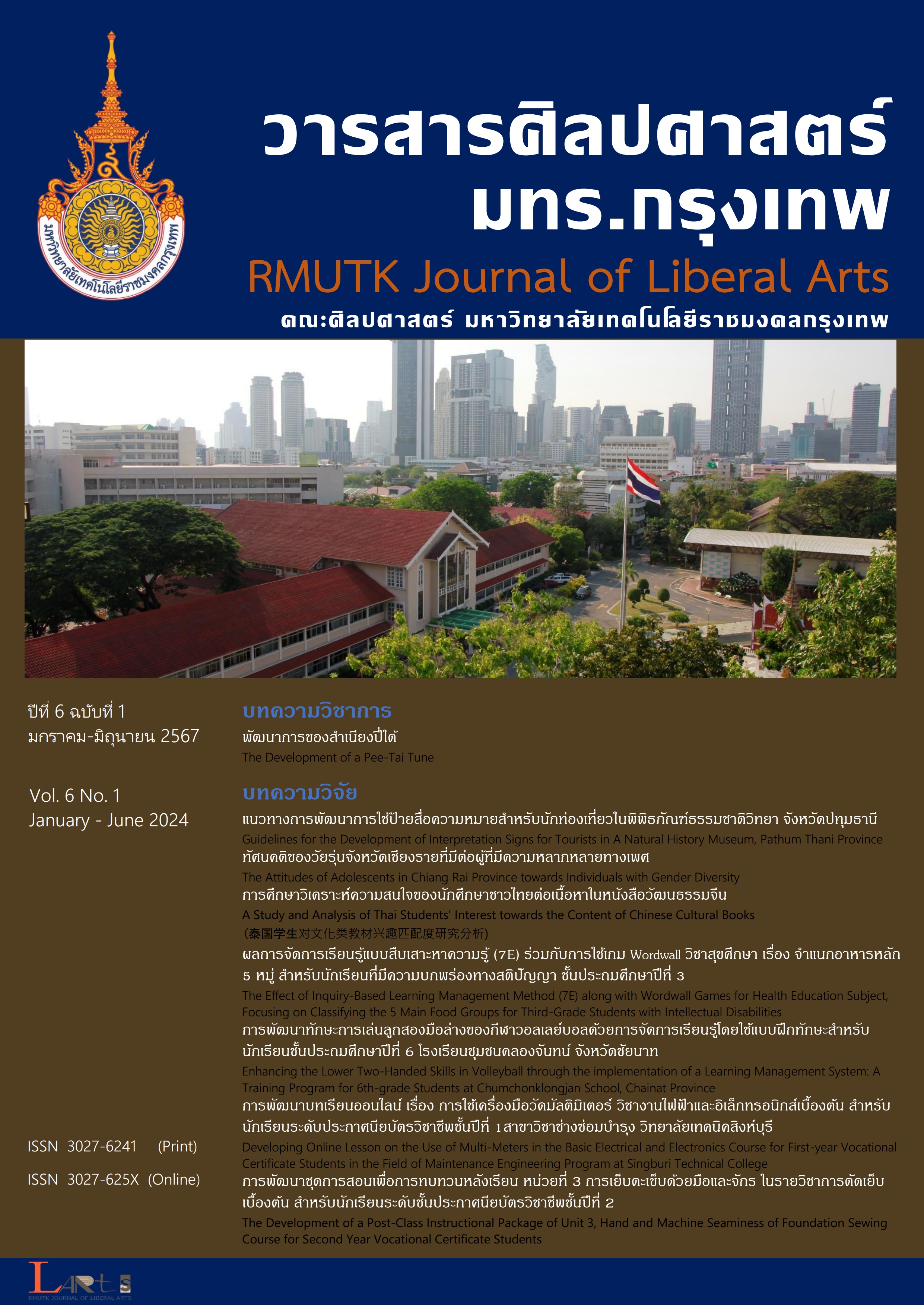The Development of a Pee-Tai Tune
Main Article Content
Abstract
The Pee–Tai, a traditional southern oboe, functions as a melodic instrument in the original Nora and Nang Talung performances. Initially, the Pee-Tai was not included; it was later added, consequently evolving the tune. This article aims to study the evolution of the Pee–Tai’s tune from the past to the present, showcasing six phases as described. (1) In the local folklore performance, the oboe can be easily crafted from natural materials and does not inherently produce a specific melody. (2) During the Imitation of the central region, the Pee–Tai craftsmen mimicked the oboes from the central region. Then the Pee–Tai players performed to the rhythm of Thab and Klong Tuk without a defined rhythm pattern. (3) Playing alongside the gamelan or Piphat songs, the performance is initiated by traditional Thai songs, influenced by the spread of central music culture in the southern region. (4) Performance of the traditional tune; however, the styles are not markedly different. (5) Categorization of the tune results from the fusion of central gamelan or Piphat with Songkhla style and the development of techniques in country music to perform in the Phatthalung style. (6) The mingling of Western musical instruments with the Pee–Tai exhibits interdependence. Nevertheless, the future of the Pee–Tai's may involve the development and alteration of its tune, showcasing a constant adaptation to the changing times.
Article Details

This work is licensed under a Creative Commons Attribution-NonCommercial-NoDerivatives 4.0 International License.
References
ไชยวุธ โกศล. (2561). ดนตรีหนังตะลุงในจังหวัดสงขลา : ความเปลี่ยนแปลงจากอดีตสู่ปัจจุบัน. วารสารศิลปกรรมศาสตร์ จุฬาลงกรณ์มหาวิทยาลัย, 5(2), 39–49.
ฐิติวุฒิ สุขศิริวัฒน์. (2559). การปรับเปลี่ยนทางดนตรีประกอบการแสดงหนังตะลุง ในพื้นที่จังหวัดภาคใต้. วารสารจันทรเกษมสาร, 22(43), 49–63.
ฝ่ายวิชาการ พีบีซี. (2552). ดนตรีไทย. พีบีซี.
พรเทพ บุญจันทร์เพ็ชร์. (2558). ประวัตินาฏศิลป์ไทย : ภาคใต้. สำนักพิมพ์โอเดียนสโตร์.
ศิริพันธ์ ถาวรทวีวงษ์. (ม.ป.ป.). สังคมและวัฒนธรรมไทย. เอกสารคำสอน รายวิชาสังคมและวัฒนธรรมไทย ANT 3057 (AN 357). คณะมนุษยศาสตร์ มหาวิทยาลัยรามคำแหง.
ศูนย์การเรียนรู้ด้วยตนเอง คณะศิลปศาสตร์ มหาวิทยาลัยสงขลานครินทร์. (ม.ป.ป.). ดนตรีพื้นเมืองภาคใต้. https://www.naamchoop.com/know_detail.php?know_id=110&know_name=ดนตรีพื้นเมืองภาคใต้
สุจิตต์ วงษ์เทศ. (2566). โนราภาคใต้ ไปจากภาคกลาง สมัยอยุธยา. https://www.silpa-mag.com/history/article_79048
สุธิวงศ์ พงศ์ไพบูลย์. (2542). สารานุกรมวัฒนธรรมไทยภาคใต้. สยามเพรส แมเนจเม้นท์.
สุรศักดิ์ เพชรคงทอง. (2564). การแสดงดนตรีพื้นบ้านไทยที่แสดงออกถึงการสืบทอดทางศิลปวัฒนธรรมและประเพณีท้องถิ่น. วารสารมหาจุฬานาครทรรศน์, 8(2), 254–268.
อนุสิทธิ์ บุญวงศ์, และเทพิกา รอดสการ. (2563). การผลิตซ้ำทางวัฒนธรรมของดนตรีประกอบการแสดงหนังตะลุง คณะหนังน้องเดียว ลูกทุ่งวัฒนธรรม จ.นครศรีธรรมราช. วารสารราชภัฏสุราษฎร์ธานี, 7(2), 167–194.
อำนาจ นุ่นเอียด. (ม.ป.ป.). เพลงปี่หนังตะลุงและมโนราห์ โดยครูต้อย. เอกสารอัดสำเนา.
Pappas, S., & McKelvie, C. (2022). What is culture?. https://www.livescience.com/21478-what-is-culture-definition-of-culture.html


